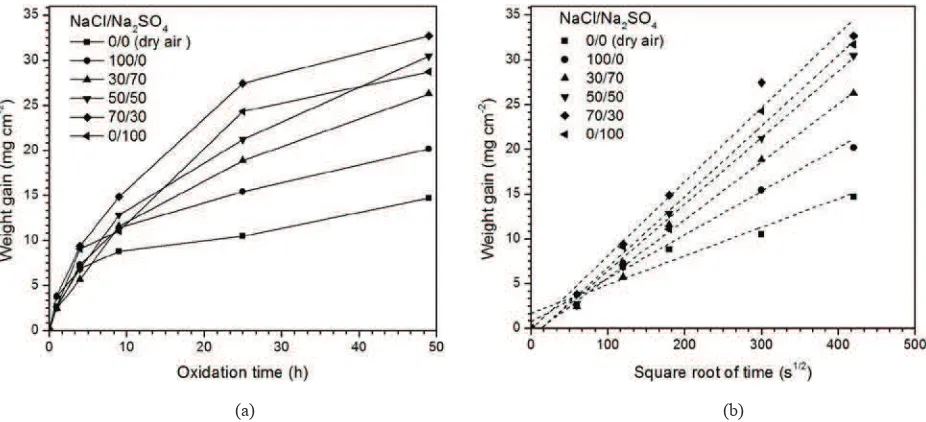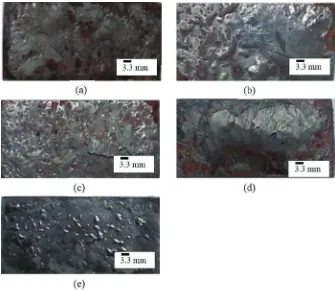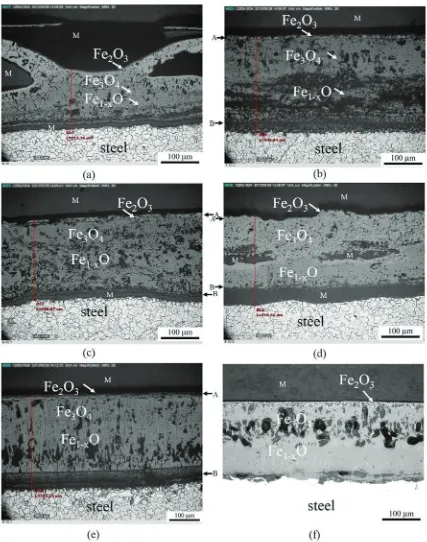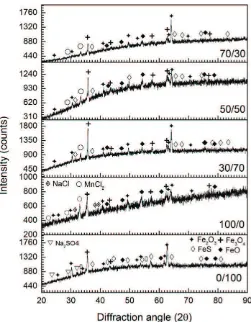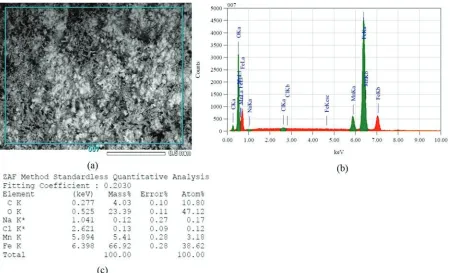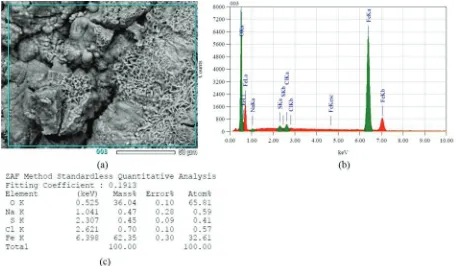Hot-corrosion of AISI 1020 steel in a molten NaCl/Na2SO4 eutectic at 700°C
Mohammad Badaruddin, Ahmad Yudi Eka Risano, Herry Wardono, and Dwi Asmi
Citation: 1788, 030066 (2017); doi: 10.1063/1.4968319
View online: http://dx.doi.org/10.1063/1.4968319
View Table of Contents: http://aip.scitation.org/toc/apc/1788/1
Hot-Corrosion of AISI 1020 Steel in a Molten NaCl/Na
2
SO
4
Eutectic at 700
°
C
Mohammad Badaruddin
1, a), Ahmad Yudi Eka Risano
1, Herry Wardono
1, and
Dwi Asmi
21Department of Mechanical Engineering, Faculty of Engineering, University of Lampung 2Department of Physics, Faculty of Mathematics and Natural Sciences, University of Lampung
Jalan Soemantri Brojonegoro No.1, Bandar Lampung 35145, Indonesia
a)Corresponding author: mbruddin@eng.unila.ac.id
Abstract. Hot-corrosion behavior and morphological development of AISI 1020 steel with 2 mg cm−2 mixtures of
various NaCl/Na2SO4 ratios at 700°C were investigated by means of weight gain measurements, Optical Microscope
(OM), X-ray diffraction (XRD), scanning electron microscopy (SEM), and energy dispersive X-ray spectroscopy (EDS). The weight gain kinetics of the steel with mixtures of salt deposits display a rapid growth rates, compared with the weight gain kinetics of AISI 1020 steel without salt deposit in dry air oxidation, and follow a steady-state parabolic law for 49 h.Chloridation and sulfidation produced by a molten NaCl/Na2SO4 on the steel induced hot-corrosion mechanism
attack, and are responsible for the formation of thicker scale. The most severe corrosion takes place with the 70 wt.% NaCl mixtures in Na2SO4. The typical Fe2O3 whisker growth in outer part scale was attributed to the FeCl3
volatilization. The formation of FeS in the innermost scale is more pronounced as the content of Na2SO4 in the mixture
is increased.
INTRODUCTION
Engineering material components in the coal fire power plants such as a boiler, heat exchanger, and pressure vessel made from cold-rolled AISI 1020 steel, undergo hot-corrosion when the sodium chloride from the ocean breeze mixes with Na2SO4 from the fuel and deposits on hot-section components, leading to accelerating attack of the steel.
Low-grade fuels with high concentrations of sulfur, vanadium, and sodium are often used in coal-fired power generation. Hot-corrosion induced in the material components of Fe-based alloys at the structural engineering exposed to an environment containing a mixture of the salt Na2SO4–NaCl [1,2], generates the serious problem. The existence of
such corrosive condensation layer on the surface of steel leads to hot corrosion which can considerably reduce the service life of high-temperature components.
Studies of hot-corrosion induced by mixtures of NaCl/Na2SO4 had been focused on Fe- and Ni- base alloys [3−6].
The addition of 75 wt.% NaCl in Na2SO4 coatings can easily cause the degradation of protective Cr2O3 layers on the
310 stainless steel at 750°C and after hot corrosion of 24 h, a lot of salts penetrated into protective Cr2O3 layers and
contacted with the matrix, causing significant sulfidation [5]. It has been reported that the friction welded low alloy steel AISI 4140 and stainless steel AISI 304 suffered accelerated corrosion in a molten salt environment of NaCl–
50%Na2SO4 at 650°C and showed spalling/sputtering of the oxide scale [4]. The steel's performance in oxidizing
environments is well established, but its behavior in corrosive environments, particularly those containing sulfidizing species and/or chlorides have not been studied extensively. Thus, the high-temperature behavior of AISI 1020 steel with NaCl and/or Na2SO4 deposits at the eutectic of NaCl/Na2SO4 melt was studied. Both corrosion kinetics evolution
EXPERIMENTAL PROCEDURE
Commercial cold-rolled AISI 1020 steel was used as experimental materials in this study. The chemical composition of the alloy is Fe–0.2C−0.05P−0.05S−0.5Mn (in wt.%). Rectangular specimens were cut into coupons with dimensions of 20 mm × 10 mm × 2 mm by a water-cooled cutting machine. Coupon specimens were ground by a precision polishing machine prior to corrosion tests. Specimens for hot corrosion tests were coated with five NaCl/Na2SO4 mixtures (100/0 wt.%, 30/70 wt.%, 50/50 wt.%, 70/30 wt.% and 0/100 wt.%, hereafter in wt.%)
separately until a total weight of deposits salts reached by 2 mg cm−2. An air gun was used to spray one of five saturated
aqueous salt solutions to produce a coat of fine salt particles on the specimen surface after the water evaporated. The process was repeated until the dry salt particles were deposited up to the designed value. Control specimens of AISI 1020 steel were kept salt free in their as polished condition. Each specimen was put in an alumina crucible of 5 Ml size with a cup, and then exposed to 700°C for 1−49 h inbox furnace under a static air.
The corrosion products were analyzed by XRD using monochromatic CuKα radiation operated at 40 kV and 100 mA. XRD data were compared with JCPDS standard files to identify the various phases present. Characterization of the cross-sectional scales was carried out with OM, SEM, and EDS.
RESULTS AND DISCUSSION
High Temperature Corrosion Kinetics
The corrosion kinetics of specimens with and without salt deposits are depicted in Fig.1(a) as a plot of a weight gain per unit area (mg cm−2) vs. function of oxidation time (h). This figure indicates that the weight gain kinetics under
dry air oxidation in steady state condition shows a slow weight gain growth, whereas the salt deposits is a rapid weight- gain growth oxidation, while the kinetics with salt deposits all display a rapid weight-gain growth rate involved in the steady stage and after breakaway corrosion for 49 h. The alloy with 70% NaCl mixtures revealed the highest weight gain after corrosion for 49 h, followed by that with 100% Na2SO4 deposit. The weight gain data for
all specimens with/without the salts deposits follow the parabolic law as shown in Fig. 1(a). The weight gain versus square root of oxidation time (s1/2) plots are shown in Fig 1(b) to establish the kinetics rate for determining the
parabolic rate constant (kp) of the hot- corrosion of AISI 1020 steel by linear regression.
(a) (b)
FIGURE 1. (a) Oxidation kinetics and corrosion and (b) plot of weight gain vs. square root of oxidation time for AISI 1020 steel with/without NaCl/Na2SO4 mixtures in a static air at 700°C for 49 h
The calculated parabolic rate constants are summarized in Table 1. The corrosion rates increase by many factors of kp with the addition of NaCl in the salt coatings. The corrosion rate of 100% NaCl coating is two factor of kp than
that of dry air oxidation. The highest of kp value is for the AISI 1020 steel with mixtures of 70 wt.% NaCl/30 wt.%
TABLE 1. Parabolic rate constants for AISI 1020 steel with and without NaCl/Na2SO4 deposits oxidized at 700°C for 49 h
Composition ratios of NaCl/Na2SO4 (wt.%) kp (g2 cm−4 s−1)
0/0 1.0259 × 10−9
100/0 2.3746 × 10−9
30/70 4.1977 × 10−9
50/50 5.5473 × 10−9
70/30 6.8327 × 10−9
0/100 6.2378 × 10−9
Macroscopic Observations
The surface appearance of the coupons after 9 h corrosion is shown in Fig. 2. In the case of mixtures of NaCl/Na2SO4 environment, the white color salt coating changed its color to brown with some small black spots
observed whereas negligible reaction has taken place on the steel surface specimen. A thick scale with severe scale rumpling, cracking, and buckling is observed on a steel surface with NaCl/Na2SO4 deposits as shown in Fig. 2(a) to
(d). The strongest corrosion is seen in low carbon steel with 70/30 wt.% (NaCl/Na2SO4) deposits as illustrated in Fig.
2(d). In addition, locally spelled oxides were identified on the surface of specimen with which remained in the molten salt as dispersed particles after specimen removal as depicted in Fig. 2(d). This can partly explain the weight loss shown in the corresponding weight gain curve as shown in Fig. 1(a). The surface of the specimen with Na2SO4
deposit shows the little buckling oxide on a macro scale. The dark gray color and texture of scale on the steel surface with Na2SO4 deposit was different from that on the steel surface with mixtures of NaCl/Na2SO4 as shown
in Fig. 2(e).
FIGURE 2. Magnification of macrographs of coupon specimens with different mixtures of NaCl/Na2SO4 deposits (a) 100/0,
Corrosion Morphology and Phase Constitutions
The oxidation behavior of carbon steel with NaCl, Na2SO4, and mixtures of both salt is relatively complicated and
depends on temperature. The mixtures with compositions of 70%, 50%, and 30 % wt. NaCl were all completely melted at 700°C [7], indicating that Na2SO4 plays an important role as a source of acidic- and basic-fluxing, accelerating
oxidation of the steel by hot-corrosion mechanism. During initial oxidation, low carbon steel exhibits accelerated oxidation owing to the reaction of oxide scale and NaCl/Na2SO4 coating. This initial stage is succeeded by a rapid
oxidation rate, which is probably caused by reaction among iron, oxygen, and chloride on the steel substrate, forming Fe-oxide scale, leading to an increase in the corrosion kinetics. During rapid oxidation rate, the scale develops considerable porosity, as well as gaps between the oxide layers. Under these conditions, the oxidation rate is extremely sensitive to the amount of chlorine and sulfur gas in the atmosphere. Furthermore, oxidation dominates the entire corrosion reaction, despite the volatilization of the sodium chloride by elevating temperature or conversion to sodium sulfate by reaction with SO3. As reported by Tsaur et al. [5], the presence of NaCl in the mixtures of NaCl/Na2SO4
could occur the most severe corrosion attack on high chromium content alloys. The addition of 75 wt.% NaCl in Na2SO4 coatings can easily crack of protective Cr2O3 layers and increase the amount of sulfur penetrated into the
substrate, and then the corrosion of alloys was increased. The low-melting point of NaCl/Na2SO4 eutectic penetrates
the oxide scale via the capillary effect [5] through pores and voids on the scale, and reacts with the steel substrate to cause oxidation. Regarding a side view of thermodynamics perspective, the final product of high-temperature corrosion is that with the lowest free energy in the system [8]. Comparison of the free energy of chloride, sulfide, and oxide indicates that the oxide is the corrosion product with the lowest free energy [5]. In the combined Cl–S–O atmosphere, oxide is the final constitution of the scale produced by hot-corrosion of AISI 1020 steel exposed to an environment containing Cl and S as shown in Fig. 3. In addition, all XRD analyses indicate that the constitutions of corrosion products are all iron oxides (Fig. 4).
The typical surface morphologies of specimens after high-temperature corrosion are shown in Fig. 3. All the scale formed by high-temperature corrosion has multi-layered structures with pores distributed on the scale in large numbers. The scales retain attachment on specimen surface with a small spallation (Fig. 3(a)). The scale morphologies as shown in Fig. 3(a) to (f) produced by a hot-corrosion of AISI 1020 steel with/without mixtures of NaCl/Na2SO4 at 700 ºC for 49 h, indicate that there are very dense pores existing on the surface of the main scale, as
depicted in Fig. 3. In addition, the thickness of the scale is much greater than that of scale produced by a dry oxidation of AISI 1020 steel (Fig. 3(f)). The phase constitutions of the scales formed on the steel are regardless of hot-corrosion of AISI 1020 steel in mixtures of NaCl/Na2SO4 environment after 9 h of hot-corrosion at 700°C is
shown in Fig. 4. Figure 4 shows the typical XRD patterns that the phase constitutions of scale formed from outside to inside are Fe2O3, Fe3O4, and Fe1−XO. The outermost part of scale the marker “A” indicated contains Na2SO4, and
the innermost part of scale the marker “B” indicated in Fig. 3(b) to (e) includes a very small amount of FeS. Figure 3a shows that the Fe2O3 scale produced by hot- corrosion of AISI 1020 steel with 100 wt.% NaCl deposit, is thicker
than that of the Fe2O3 scale produced by hot- corrosion of AISI 1020 steel with mixtures of NaCl/Na2SO4 (Fig. 3b−e). This shows that the presence of higher composition of NaCl in Na2SO4 decreases a thickness of Fe2O3
scale after 49 h hot-corrosion. Distribution of iron oxides in the scale, as shown in Fig. 3(b) to (d), are the same as that obtained when the steel with 100 wt.% Na2SO4 subjected to hot-corrosion at 700 ºC for 49 h. Furthermore, the
innermost part of the scale the marker “B” as shown in Fig. 3(b) has a large amount of FeS, and Na2SO4 can be
found on the outermost part of the scale, as confirmed by XRD analysis (Fig. 4).
It was known that Fe2O3, Fe3O4, and Fe1−XO are the typical oxides formed on carbon steel when the steel was
oxidized at the temperature higher than 570°C [9]. The constituents of scales showed the same results in this study, revealing that the corrosion of specimens was dominated by oxidation. The Fe1−XO is a p-type metal deficit
semiconductor which contains large amount of defects [9], facilitating the iron ions to move outwards through the Fe1−XO layer. Thus it becomes a reason that the Fe1−XO layer is much thicker than the Fe3O4 and Fe2O3 layers.
Besides that, in Fig. 3(e), a multi-layered structure is observed as a result from hot-corrosion of the steel with 100 wt.% Na2SO4 deposit, which may become a reason why the corrosion kinetics of the steel increases for 49 h of
hot-corrosion at 700 ºC (Fig. 1(a)). On the contrary, the steel with 100 wt.% NaCl and mixtures of NaCl/Na2SO4
deposits show the lower corrosion kinetics is caused by vaporization Fe-chloride, as shown in Fig. 1(a). Thermodynamic calculations predict [5] that NaCl can be converted to Na2SO4 via a reaction with SO2 in the
atmosphere containing a high pressure of oxygen. Accordingly, the XRD analysis identifies Na2SO4, as indicated in
Fig. 4. However, owing to the wetting effect through the formation of NaCl–Na2SO4 eutectic at 628°C [7], as well as
the oxychloridation [5] of Fe in reaction with NaCl and oxygen to form Fe2O3, NaCl eventually may be consumed
FIGURE 3. OM cross-sectional micrographs of AISI 1020 steel with and without NaCl/Na2SO4 coated exposed at 700°C
for 49 h. (a) Pre-coated NaCl/Na2SO4 mixtures with the ratio of 100/0, (b) 70/30, (c) 50/50, (d) 30/70, (e) 0/100 and (f) dry
FIGURE 4. XRD analyses of corrosion products formed on AISI 1020 steel with a different ratios of NaCl/Na2SO4
deposits exposed at 700°C for 9 h
Figure 5(a) illustrates the surface morphology of AISI 1020 steel with 100 wt.% NaCl after hot corrosion of 49 h at 700°C. It can be seen that particles of corrosion products appear the Fe2O3 whiskers growth in outer part scale, and
the corrosion products have formed films on the surface of AISI 1020 steel. Moreover, there are many white coarse particles growth with Fe2O3 whiskers growth. Figure 5(b) is the EDS spectrum confirmed that Mn detected in the
scale after hot corrosion of 49 h at 700 °C. Moreover, the EDS quantitative analysis results in Fig. 5(c), show the composition of 3.18 at.% Mn detected in the scale. The outward diffusion of Mn2+ cations through the scale leads
the coalescence of vacancies to form voids on the steel substrate [10]. As shown in Fig. 5(c), the high composition of Mn (at.%) on the scale indicates that the outward migration of manganese ion leads to an obvious formation of MnCl2.
It shows that not only FeCl3 formed but also MnCl2 formed during hot-corrosion of AISI 1020 steel with 100 wt.%
NaCl deposit. Because the low melting temperature of MnCl2 is 650°C [11], closing to the testing temperature in the
present study. This result is evident with the XRD analysis in Fig. 4. Therefore, the white coarse particles formed together with the whiskers growth on the AISI 1020 steel substrate can be confirmed as the MnCl2 particles. In
addition, the low melting of FeCl3 is 304°C [11], and can cause the FeCl3 moving out via a crack path in the oxide
scale to the high pressure of oxygen environment, and eventually react again with oxygen to form Fe2O3 and
release Cl2 gas again to the atmosphere. This is a reason why the Fe2O3 scale in 100 wt.% NaCl deposit on the steel
has a thicker layer (Fig. 3(a)). This chlorine was liberated by the reaction between NaCl, O2, and Fe which causes
FIGURE 5. (a) SEM surface morphology of AISI 1020 steel with 100 wt.% NaCl deposit after hot corrosion of 49 h at 700 °C, (b) its EDS spectrum, and (c) EDS quantitative analyses in part (a)
Although the salt mixtures exist in a completely liquid phase at 700 °C, the fast evaporation characteristics of NaCl led to a residue of solid Na2SO4 on the specimen surface, as confirmed by XRD analysis (Fig. 4). Thus, in the initial
stage oxidation, a molten NaCl could degrade scales on the steel surface. The scale structures formed by hot-corrosion of steel with 30/70 wt.% and 0/100 wt.% (NaCl/Na2SO4) are characterized by more wide-spread larger pores than in
the structure formed by hot-corrosion of steel with 70/30 wt.% and 100/0 wt.% (NaCl/Na2SO4). The formation of iron
sulfide at the innermost scale may be formed by a self-sustaining sulfidation reaction between Na2SO4/SO3 formed
between the scale and the substrate during hot-corrosion process. In a mixed salt environment, sulfur was incorporated into scale and proceeds to a sulfide formation in the steel substrate. Figure 6(a) depicts the surface morphology of AISI 1020 steel with mixtures of 70/30 wt.% NaCl/Na2SO4 after hot corrosion of 49 h at 700 °C. It is seen that
corrosion products have formed density films on the surface and cracks emerge by the stress generated during films grow during hot-corrosion process. Some Fe2O3 whisker growth in the scale proves that the chloridation process
induced hot- corrosion of the steel is the same with Fig. 5(a). Figure 6(b) is the EDS spectrum analysis after hot corrosion of 49 h at 700 °C. It reveals that Cl and S are detected in the surface scale. The low composition (at.%) of S in the scale (Fig. 6(c)) show that S penetrated into the scale via a crack path in the scale to form FeS, as confirmed by XRD results (Fig. 4). The large quantities of SO2 molecules diffuse inwards from the salt/scale
interface along micro-cracks or through the pores of the scale to the metal/scale interface [12]. In contrast, since the diffusion of Fe ion through the sulfide FeS is faster than through wustite [13], the sulfide forms a continuous layer in the innermost oxide, and scale growth rate increases rapidly. Evidently, the porous scale formed in a salt deposit promotes the inward diffusion of SO2 and sulfide formation, as revealed in Fig. 3(b). Sulfide formation in the inner
part of the scale also contributes to the rapid oxidation, as shown in Fig. 1a. In the atmosphere that contains Cl and S gas species, molecules of both species may reach the gap between the substrate and scale interface from the oxide scale via micro-cracks. However, when SO3 diffuses from the atmosphere to the steel substrate, a thick layer of
Fe1−XO develops, with many pores in the scale, which are means of access. This phenomenon facilitates the
FIGURE 6. (a) SEM surface morphology of AISI 1020 steel with mixtures of 70/30 wt.% (NaCl/Na2SO4) deposit after hot corrosion
of 49 h at 700°C (b) its EDS spectrum, and (c) EDS quantitative analyses results in part (a)
CONCLUSIONS
The mixtures of 70% NaCl contained in a Na2SO4 can react rapidly and form Na2SO4–NaCl eutectics. The low-
melting eutectic of Na2SO4–NaCl on steel surface for 49 h at 700ºC accelerates the corrosion kinetics of the steel.
The mixtures with 70% NaCl showed the most severe corrosion on the steel substrate. Furthermore, the molten eutectic salt can become a capillary transport for penetrating Cl and S into iron-oxide scale. Fe2O3, Fe3O4, and Fe1-xO
are main corrosion products on the AISI 1020 steel substrate. MnCl2 formed with the Fe2O3 whisker growth in the
scale is caused by the migration of manganese ions outward from the steel substrate. In addition, iron-sulfide (FeS) is found with increasing Na2SO4 content in the salt coating layer. The hot-corrosion of scale morphologies induced by
increasing the composition of NaCl in Na2SO4 shows volatilation of iron-chlorides results, while the features of scale
morphology of the steel produced by increasing the Na2SO4 content in the mixtures show a large amount of sulfides
formation in innermost scale.
ACKNOWLEDGEMENT
REFERENCES
1.
G. Liu, Y. Zhang, Z. Ni and R. Huang, Const. Build. Materials115, 1–5 (2016)2.
D. Lindberg, J. Niemi, M. Engblom, P. Yrjas, T. Lauren and M. Hupa, Fuel Process. Technology141, 285−298 (2016)3.
L. Zheng, Z. Maicang and D. Jianxin, Maters. Design32, 1981−1989 (2011)4.
N. Arivazhagan, S. Narayanan, S. Singh, S. Prakash and G. M. Reddy, Maters. Design34, 459–468 (2012)5.
C. C. Tsaur, J. C. Rock, C. J. Wang, Y. H. Su, Maters. Chem. Physics89, 445–453 (2005)6.
Y. Niu, F. Gesmundo, F. Viani, W. Wu, Oxid. Metals42, 265–284 (1994)7.
M.A. Clevinger, K.M. Kessel and C.G. Messina, in: H.M. Ondik (Ed.), Phase Diagrams for Ceramists, (TheAmerican Ceramic Society Inc., Columbus, Ohio, 1989), p.109
8.
C. J. Wang and J. Y. Pan, Maters. Chem. Physics82, 965−973 (2003)9.
N. Birks, G. H. Meier and F. S. Pettit, Introduction to the high-temperature oxidation of metals 2nd Ed.,(Cambridge University Press, Cambridge, 2006), pp. 83−86
